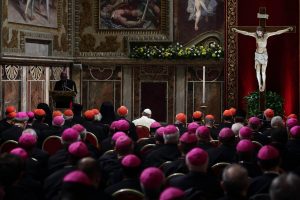
Recent reports of sexual abuse in the Catholic Church in the U.S. show similar patterns to those found in the period before 2002 as well as in other Western nations, according to researchers speaking at an April conference at Fordham University in New York, which RW attended. Researchers Margaret Smith and Karen Terry of John Jay College compared recent findings on the priestly sexual abuse with the landmark research they conducted on the issue in 2002. Since their research, there have been 8,645 victims who came forward to report abuse, as reported in the United States Conference of Catholic Bishops’ annual reports that are tallied by the Center for Applied Research on the Apostolate (CARA) at Georgetown University. Smith and Terry also looked at recent studies of priestly sex abuse in Australia and Germany and found similar patterns to those uncovered in their 2002 research: “80.9 percent of victims that we knew of in 2002 were male, and almost 60 percent between ten and fourteen…The percentages are exactly the same [in Germany and Australia],” Smith said.
These patterns also show up in the state commission reports of abuse cases, such as the one in Pennsylvania last year. Smith added that the intervening years’ reports also confirmed that the peak period of abuse remained between 1974 and 1982. The percentage of priests involved in abuse cases in the other countries was similar to the 4 percent figure in the U.S., at 7 percent in Australia and 4.4 percent in Germany. In the U.S. male adolescents were the primary victims, and more than half of the priests involved had only one known victim. This was replicated in Germany and Australia as well. The conference participants agreed that the focus in 2019 has shifted from the abuse or abusers themselves to the accountability of leaders who covered up or allegedly covered up the allegations of abuse.
The concluding speaker at the conference, Hans Zollner, SJ, president of the Center for Child Protection at Rome’s Gregorian University, said that the new spotlight on church leaders is most prominent in the U.S., but that in other regions, such as Central and Eastern Europe, addressing priestly abuse in general is not a priority in the churches. In 75 percent of countries “they have not started to talk about it,” he said. The February consultation that Pope Francis held for bishops at the Vatican was “partly successful” in raising the seriousness of the accountability problem and trying to get the whole church on board to address this issue and abuse in general. But he said it continues to be the U.S., Ireland, Australia, and Germany that have put in place the highest standards, regulations and training programs for bishops regarding reporting abuse. He said that some of the measures discussed at the consultation may still be implemented, such as giving archbishops more power to discipline bishops (rather than just the pope, as is currently the policy) and creating oversight committees dealing with abuse for bishops who may be based in isolated dioceses.
